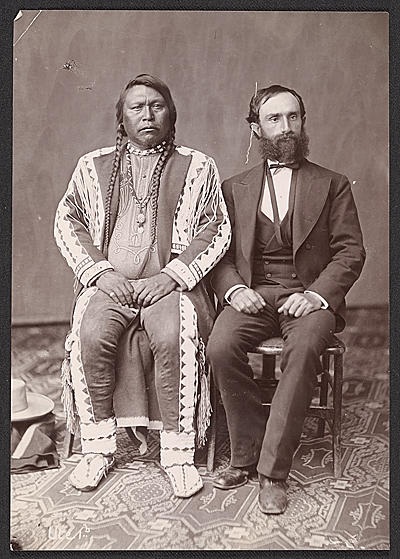
The frontier was also a process, and Jewish immigrants played an active part in it as peddlers, traders, prospectors, speculators, and entrepreneurs. Jews too linked "land" and "free," and they too participated in the great struggle against native peoples for American land, albeit with their own uniquely Jewish articulations. To the frontier of the second half of the nineteenth century and into the early twentieth, they unwittingly brought medieval and early modern European expectations and limitations of what their relationships with land could be. There they vied with native people, and encountered a range of competing conceptualizations of soil, landscape, territory, space, and earth. Thousands cast their lots among the German, Irish, Scandinavian, and American-born migrants who rushed west to seize their opportunity for land. Jewish peddlers traversed the in-between places along the shifting frontier, in and on the borders of native territories and government-created Indian reserves, helping connect spaces into larger economic zones.
Land provided a site of longing and resolution for American Jews, and they most certainly wanted to belong to it, to be of it if not from it, to imagine a deep connection to it that implied an end to exile, a rootedness. They wrote about land in poems and novels, diaries, letters, and memoirs, in newspapers, local histories, and travelogues in English, German, and Yiddish, often eloquently articulating wishes and realities of its landscape, its power, its newness, its salvific potential.
Along with the economic opportunities promised by the West, those Jews who migrated to America's frontiers desired land. For them, land ownership offered some critical entitlements: an avenue for social and economic mobility, a sense of belonging in the project of establishing the nation, a place for civic inclusion and religious latitude, the experience of motility unrestricted by a powerful state, and a reversal of the predicament of landlessness Jews faced in Europe. The battle against Native Americans for supremacy over the land doubled as a battle for "ownership" of America itself, for advancing civilization and establishing the American national project; Jews took pride in their active role in this central drama of American life and fate.
Their interest in western American lands blended the fantastical and the concrete, but almost always spoke to underlying modern Jewish anxieties. Some took on-the-ground measures to own, settle, or work the land. Large-scale fantasies or attempts to expand Jewish life on American land provided an (unrealized) answer to the modern Jewish Problem. Take, for example, the Scottish Baronet Sir Alexander Cuming's suggestion to the British Crown in the 1730s that 300,000 Jews be relocated onto Cherokee lands, paid for by the Jews' own expense, as a strategy to relieve the British national debt—the Jews could essentially buy nationhood in British colonial territory. Or take the eighteenthcentury Gratz family, who purchased 321,000 acres west of the Ohio River on land ceded by the Six Nations. The Gratz's aspired to own the entire "virgin" Ohio Valley to the Mississippi River and apparently envisioned a veritable empire of villages, towns, and cities in the "Indian no-man's-land whose warring Shawnee and Delaware and Miami would be subdued and their forests cleared," according to one historian of the Jewish frontier.
There's Mordecai Manuel Noah's famous attempt to build a semi-sovereign Jewish national home on Grand Island, New York in 1825, a site to which all of the Israelites living in galut—including Native Americans—would be ingathered. Or Julius Stern's 1843 proposal, nearly a decade before the settlement of Nebraska, that a colony of Jews be established in an area west of the Mississippi River. In the very first issue of Isaac Leeser's influential newspaper, The Occident, Stern suggested that if 70,000 Jews could settle a large tract of land in one of the western territories, "where Congress disposes of the land at $1.25 per acre," they would be eligible to apply for statehood. Take the Posen-born Solomon Barth, who would become known as "the Father of Apache County," on account of his purchase from the Apache and one-time exclusive ownership of a huge swath of what is now Utah and Arizona, including the Grand Canyon.
It had even been suggested that an Alaskan Jewish fur trader named Jack Goldstone, in cahoots with the San Franciscan business giant Louis Schloss—one of the chief investors who bought out the Russian American Company, which was renamed the Alaska Commercial Company—deserved credit for convincing the United States to acquire Russian America. Or, finally, Otto Mears, the developer, "founding father," "civilizer," and "path-breaker," "breaker of the Navajo resistance" of Colorado, who convinced Chief Ouray and his Ute Indians to cede millions of acres of land for commercial settlement. Mears's effort to secure Colorado lands from the Ute, despite a bribery charge for which the federal government eventually exonerated him, was understood as a valuable contribution to closing the frontier and forging the nation. (Mears was later involved in the removal of the Ute to the present site of Uinta reservation in Utah, and the establishment of a new Indian agency there.)
These large-scale cases of individual Jews owning enormous swathes of American land share something in common with the great communal efforts of the early twentiethcentury agricultural colonization schemes, which attempted to place eastern European and Russian Jews on farmlands in America's heartland (and in the Canadian prairies). The movement embraced a vision of harmony between Jewishness and Americanization as much as it did the harmony between Jew and land, though it largely failed to transform these Jews into paragons of by then outdated Jacksonian virtue or embodiments of the Yeoman farmer ideal with his Protestant thrift and manly sweat. It was not only a scheme to circumvent restrictive immigration policy and save Jewish lives; it was a deep expression of Jewish anxiety about Jewish productivity.
All of these briefly articulated exploits on American land capture something of the widely shared idea of the great majority of late nineteenth- and early twentiethcentury Jews living in the American West, namely, of the land not merely an asset, but as a redemptive force, a potential panacea to a series of uniquely modern Jewish problems. Most pressingly for relatively poor immigrant Jews, this meant the need to gain economic traction. But profit motive merged with other deep-seated desires, namely, the enfranchisement and sense of home it brought in America, a counter to stereotypes of Jewish luftmenschen by grounding them as landmenschen, as it were, and a corrective to the myth that Jewish men lacked the brawn for the physicality of working the land.
While owning land was not the driving force behind Jewish westward migrants' material ambitions—peddling, merchandizing, and exploiting the commercial opportunities that accompanied mining, homesteading, gold-rushing, and railway building dominated Western American Jews' economic activities—the sense of ownership over the idea of American land provided a flexible screen onto which Jews could project an idea of home for themselves. This Jewish desire for American western land answered some of the most elemental anxieties of modern Jewry. Being connected to the land showed Jews' muscular ruggedness, their fitness for the expansion enterprise. In wrestling the West from native people, Jews experienced the reversal of their recent experience in Europe and Russia, where they had suffered as the colonized. Western American Jews earned for themselves a sense of home among an emerging nation, the end of exile, and an almost aboriginal sense of belonging in America.


 David S. Koffman is an assistant professor in the Department of History at York University in Toronto where he teaches the modern Jewish experience. He is finishing his first book, about encounters between Jews and Native Americans in the late nineteenth and early twentieth centuries. He is the co-editor of the journal Canadian Jewish Studies.
David S. Koffman is an assistant professor in the Department of History at York University in Toronto where he teaches the modern Jewish experience. He is finishing his first book, about encounters between Jews and Native Americans in the late nineteenth and early twentieth centuries. He is the co-editor of the journal Canadian Jewish Studies.